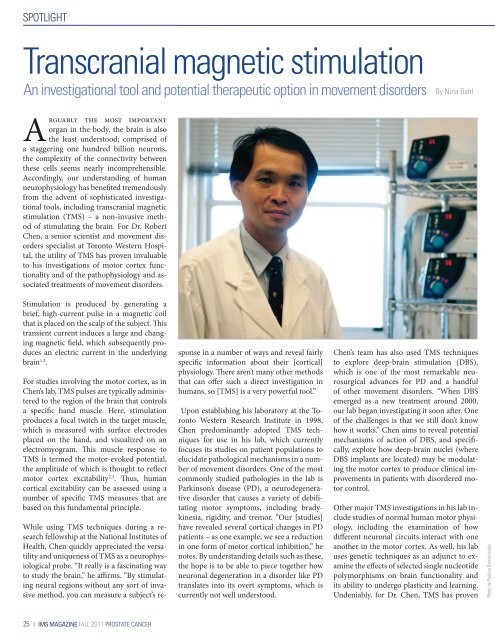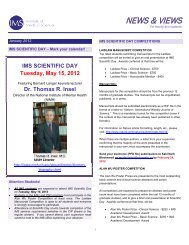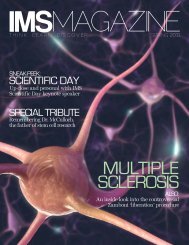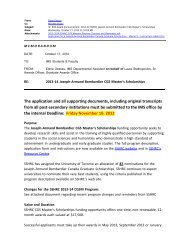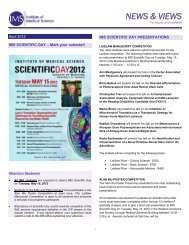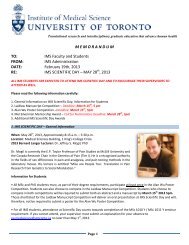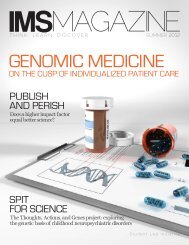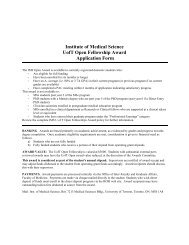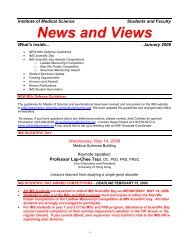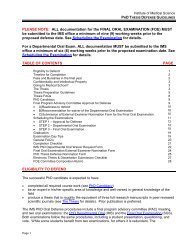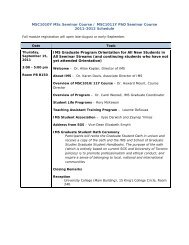Fall 2011 - Institute of Medical Science - University of Toronto
Fall 2011 - Institute of Medical Science - University of Toronto
Fall 2011 - Institute of Medical Science - University of Toronto
You also want an ePaper? Increase the reach of your titles
YUMPU automatically turns print PDFs into web optimized ePapers that Google loves.
SPOTLIGHT<br />
Transcranial magnetic stimulation<br />
An investigational tool and potential therapeutic option in movement disorders<br />
By Nina Bahl<br />
Arguably the most important<br />
organ in the body, the brain is also<br />
the least understood; comprised <strong>of</strong><br />
a staggering one hundred billion neurons,<br />
the complexity <strong>of</strong> the connectivity between<br />
these cells seems nearly incomprehensible.<br />
Accordingly, our understanding <strong>of</strong> human<br />
neurophysiology has benefited tremendously<br />
from the advent <strong>of</strong> sophisticated investigational<br />
tools, including transcranial magnetic<br />
stimulation (TMS) – a non-invasive method<br />
<strong>of</strong> stimulating the brain. For Dr. Robert<br />
Chen, a senior scientist and movement disorders<br />
specialist at <strong>Toronto</strong> Western Hospital,<br />
the utility <strong>of</strong> TMS has proven invaluable<br />
to his investigations <strong>of</strong> motor cortex functionality<br />
and <strong>of</strong> the pathophysiology and associated<br />
treatments <strong>of</strong> movement disorders.<br />
Stimulation is produced by generating a<br />
brief, high-current pulse in a magnetic coil<br />
that is placed on the scalp <strong>of</strong> the subject. This<br />
transient current induces a large and changing<br />
magnetic field, which subsequently produces<br />
an electric current in the underlying<br />
brain 1,2 .<br />
For studies involving the motor cortex, as in<br />
Chen’s lab, TMS pulses are typically administered<br />
to the region <strong>of</strong> the brain that controls<br />
a specific hand muscle. Here, stimulation<br />
produces a focal twitch in the target muscle,<br />
which is measured with surface electrodes<br />
placed on the hand, and visualized on an<br />
electromyogram. This muscle response to<br />
TMS is termed the motor-evoked potential,<br />
the amplitude <strong>of</strong> which is thought to reflect<br />
motor cortex excitability 2,3 . Thus, human<br />
cortical excitability can be assessed using a<br />
number <strong>of</strong> specific TMS measures that are<br />
based on this fundamental principle.<br />
While using TMS techniques during a research<br />
fellowship at the National <strong>Institute</strong>s <strong>of</strong><br />
Health, Chen quickly appreciated the versatility<br />
and uniqueness <strong>of</strong> TMS as a neurophysiological<br />
probe. “It really is a fascinating way<br />
to study the brain,” he affirms. “By stimulating<br />
neural regions without any sort <strong>of</strong> invasive<br />
method, you can measure a subject’s re-<br />
sponse in a number <strong>of</strong> ways and reveal fairly<br />
specific information about their [cortical]<br />
physiology. There aren’t many other methods<br />
that can <strong>of</strong>fer such a direct investigation in<br />
humans, so [TMS] is a very powerful tool.”<br />
Upon establishing his laboratory at the <strong>Toronto</strong><br />
Western Research <strong>Institute</strong> in 1998,<br />
Chen predominantly adopted TMS techniques<br />
for use in his lab, which currently<br />
focuses its studies on patient populations to<br />
elucidate pathological mechanisms in a number<br />
<strong>of</strong> movement disorders. One <strong>of</strong> the most<br />
commonly studied pathologies in the lab is<br />
Parkinson’s disease (PD), a neurodegenerative<br />
disorder that causes a variety <strong>of</strong> debilitating<br />
motor symptoms, including bradykinesia,<br />
rigidity, and tremor. “Our [studies]<br />
have revealed several cortical changes in PD<br />
patients – as one example, we see a reduction<br />
in one form <strong>of</strong> motor cortical inhibition,” he<br />
notes. By understanding details such as these,<br />
the hope is to be able to piece together how<br />
neuronal degeneration in a disorder like PD<br />
translates into its overt symptoms, which is<br />
currently not well understood.<br />
Chen’s team has also used TMS techniques<br />
to explore deep-brain stimulation (DBS),<br />
which is one <strong>of</strong> the most remarkable neurosurgical<br />
advances for PD and a handful<br />
<strong>of</strong> other movement disorders. “When DBS<br />
emerged as a new treatment around 2000,<br />
our lab began investigating it soon after. One<br />
<strong>of</strong> the challenges is that we still don’t know<br />
how it works.” Chen aims to reveal potential<br />
mechanisms <strong>of</strong> action <strong>of</strong> DBS, and specifically,<br />
explore how deep-brain nuclei (where<br />
DBS implants are located) may be modulating<br />
the motor cortex to produce clinical improvements<br />
in patients with disordered motor<br />
control.<br />
Other major TMS investigations in his lab include<br />
studies <strong>of</strong> normal human motor physiology,<br />
including the examination <strong>of</strong> how<br />
different neuronal circuits interact with one<br />
another in the motor cortex. As well, his lab<br />
uses genetic techniques as an adjunct to examine<br />
the effects <strong>of</strong> selected single nucleotide<br />
polymorphisms on brain functionality and<br />
its ability to undergo plasticity and learning.<br />
Undeniably, for Dr. Chen, TMS has proven<br />
Photo by Paulina Rzeczkowska<br />
25 | IMS MAGAZINE FALL <strong>2011</strong> PROSTATE CANCER


